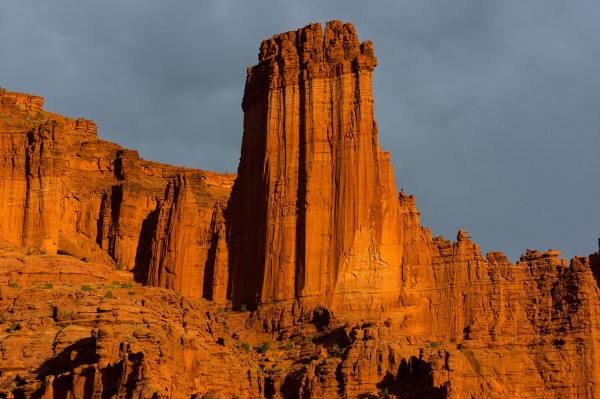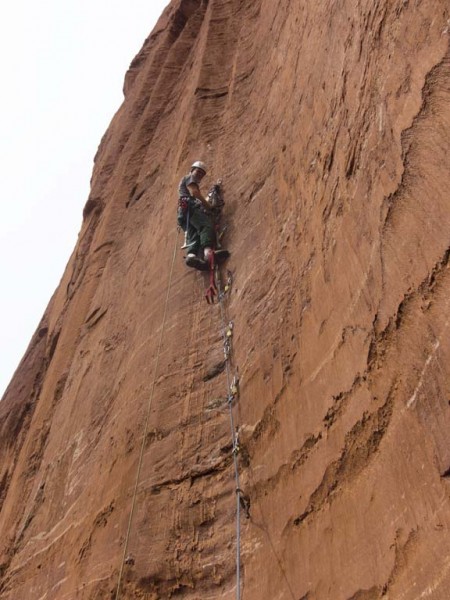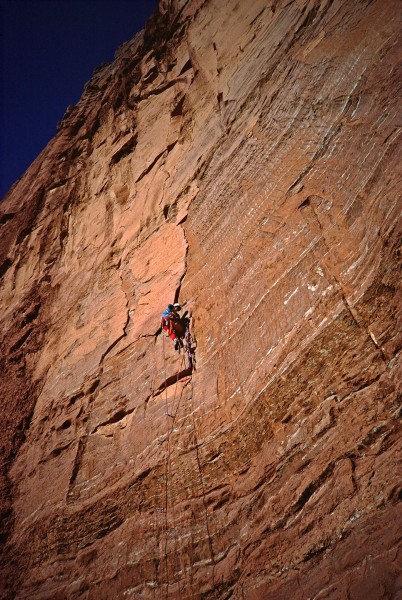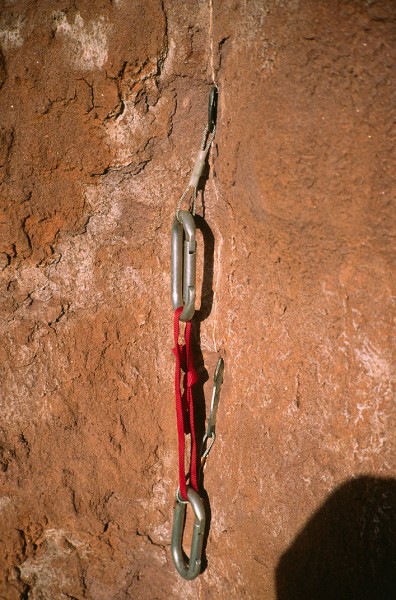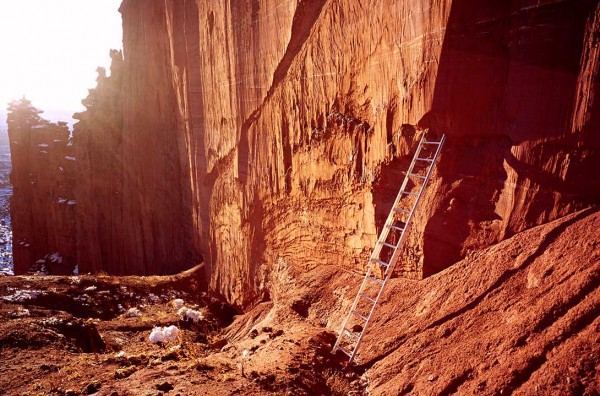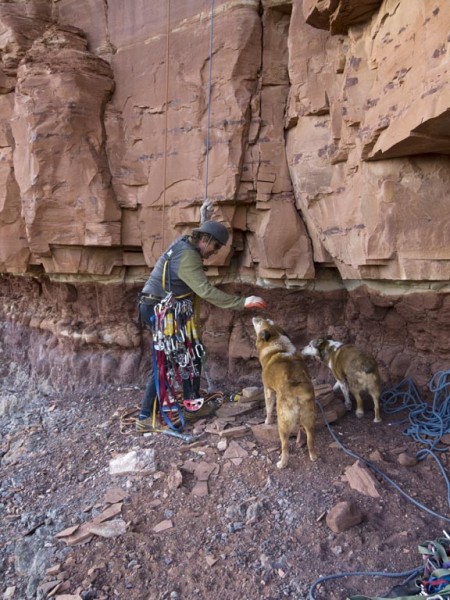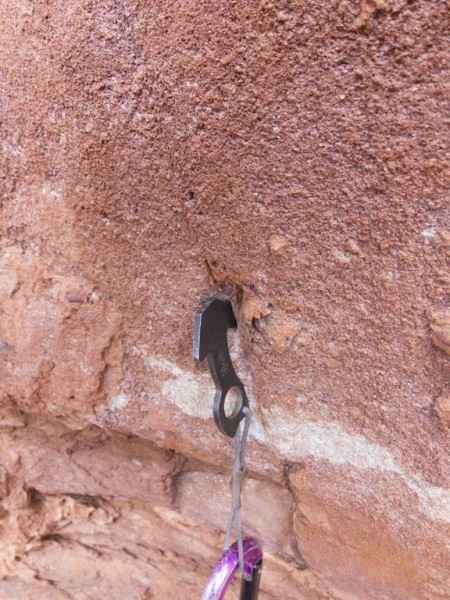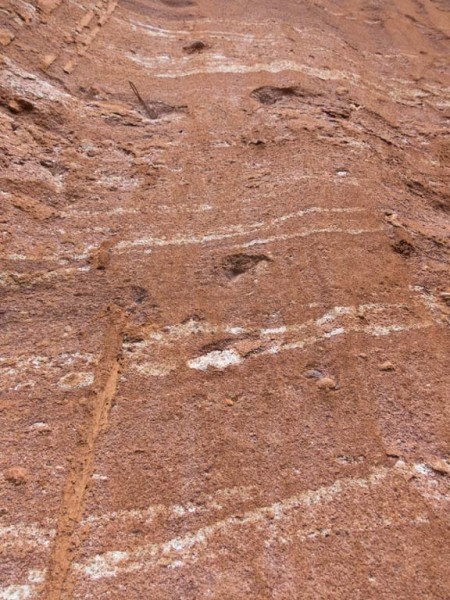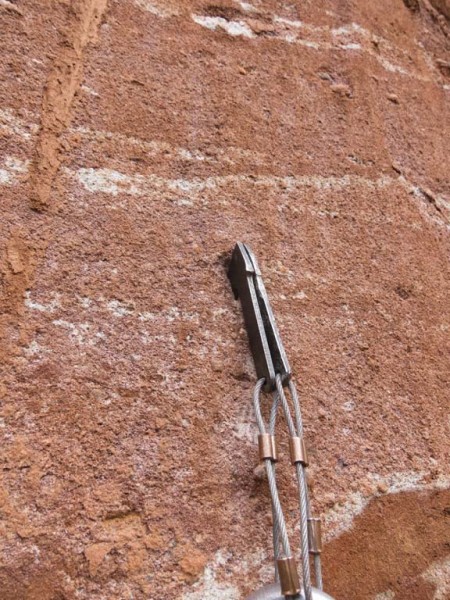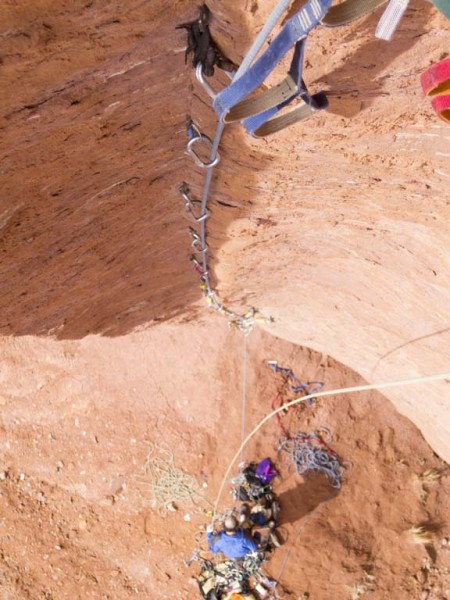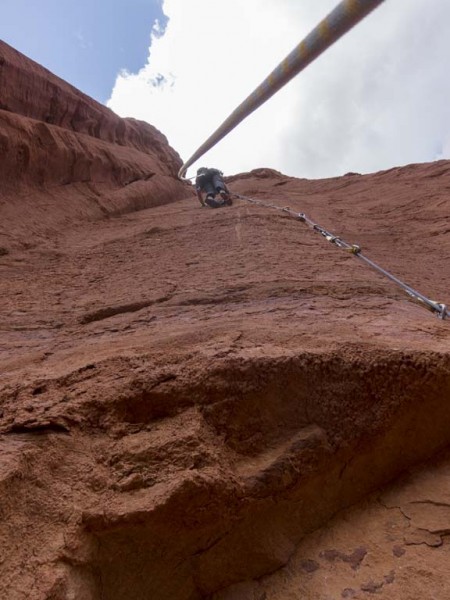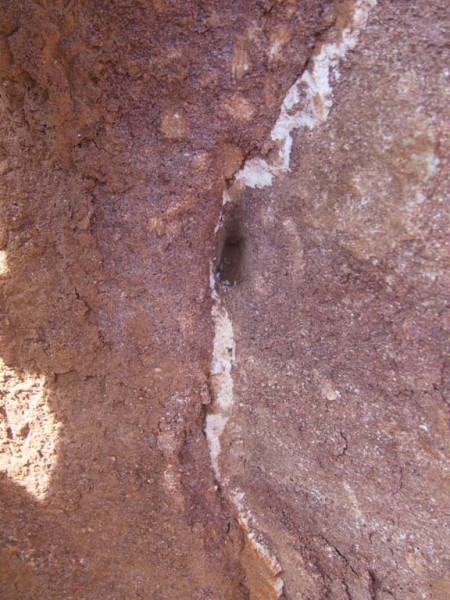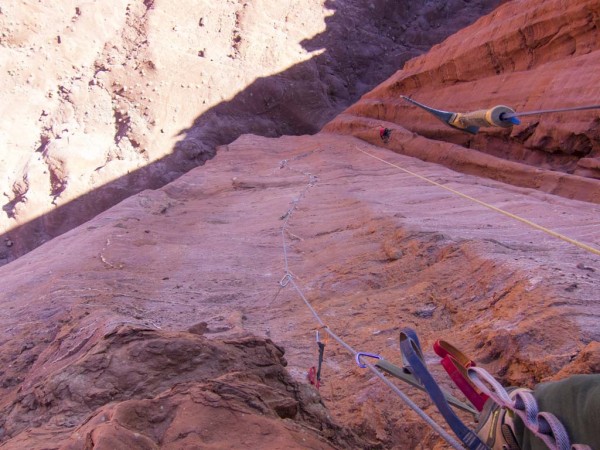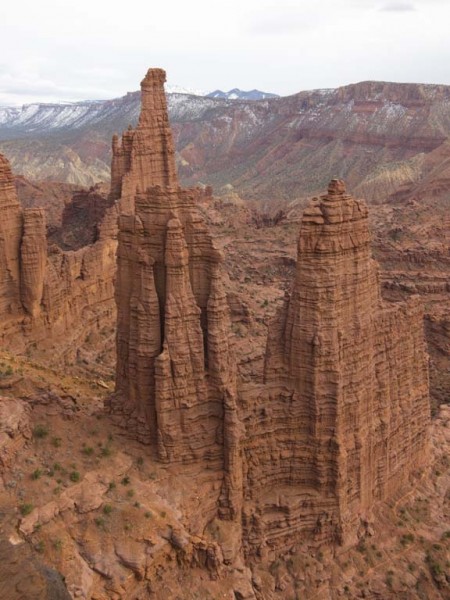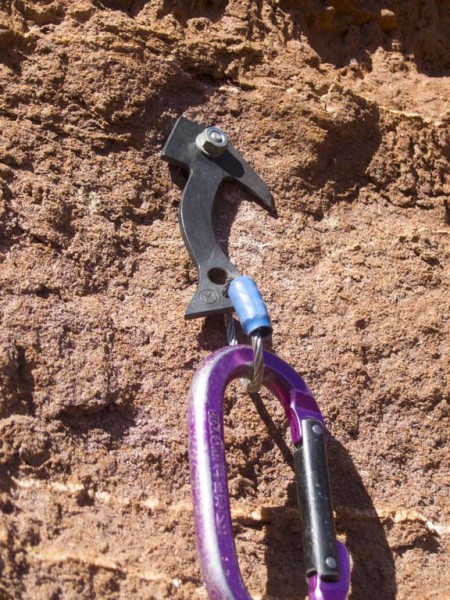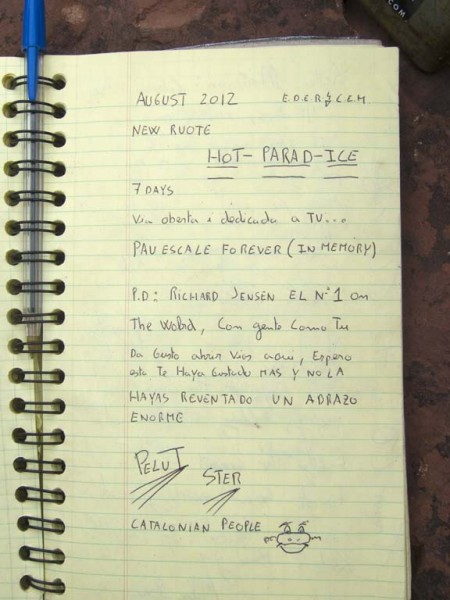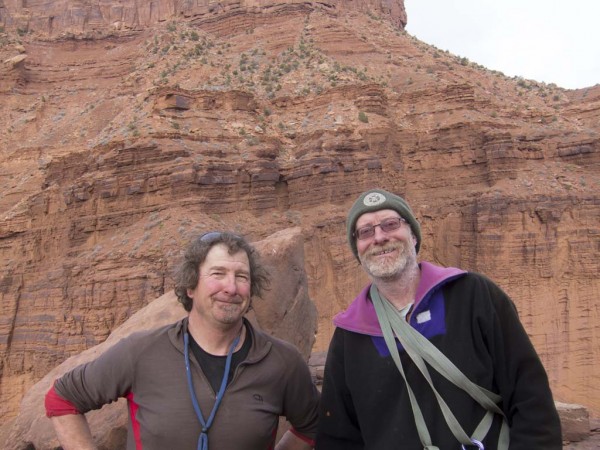Trip Report
HOT-PARAD-ICE, KINGFISHER--Second Ascent.
|
Monday April 1, 2013 5:21pm
|
|
I'm declining into grumpy retirement, but I can still stand in a pair of aiders all day. So, off we go again!
Some background info:
Over the years, I've put hours into eyeing up the beautiful, steep, curvaceous southeast face of Kingfisher. Soloed the Northeast Ridge one weekend, early 1990s. Tried for a second ascent of Death of American Democracy, with BIll Roberts, around the same time:
The monster flake Bill is nailing in the photo was creaking and groaning like a hippopotamus with severe intestinal distress, so we bailed. A couple years later we were robbed, robbed I say!--of the second ascent of Beyer's Jagged Edge by Keith Reynolds. Five years after the first ascent, Keith snuck in just a few days before our long-planned ascent......
Looking for a line of weakness on that southeast face, once even carried a ladder in, to see if Beaks could bite 20 feet off the ground:
No luck. Fast forward a couple decades. Robbed, again! of a line Chip Wilson and I had eyed up, when Jeremy Aslaksen and Paul Gagner established Weird Science.
Then, last summer, David Palmada climbed a new route, right up the very best part of the face.
He had earlier claimed a new route, rated "A6" on the Titan. He made four mistakes with this line.
1. Using 30-year-old Intifada as a template for style, and rating, giving this new route "A6."
2. Palmada, a sponsored climber, eagerly wrote up his route for the magazines, talking up an all-hook belay and proposing a rating of an unprecedented A6. Thus it would be by far the hardest aid climb in the US.
3. Palmada did not understand that the world of Big Wall Climbing in the US is a tight-knit (or is it tightly-wound?) community, conflicted, defensive, intensely distrustful of outsiders. It's always been this way. In the early 60s, Harvey T. Carter came close to a fistfight with Steve Roper. Harding and Robbins famously feuded over style and ethics. Beyer's own methods, trenching at will to force a difficult line up a blank face, have been largely abandoned. A good thing, I think.
There's an expectation that an aid climber will serve a long apprenticeship, absorbing the dominant ethics, honing skills, proving their mastery of the dominant paradigm, before they will be trusted, accepted.
Nailing is, in theory, unsustainable. yet it can be sustained, just, if we practitioners keep to a strict, complex, strongly-defended yet poorly defined ethic. Outsiders who are accused of transgressing these ethics can face years, decades even, of abuse, insults, of being pariahs, outcasts, scapegoats.
So, Palmada was walking into a situation where he would, inevitably, have his claims scrutinized by skeptical eyes. His fourth mistake was that, not knowing anything of this, he did not know that one does not have to be from Europe to be an outsider. His claims attracted the Sauron-like gaze of Richard Jensen. Someone who knows about having his own claims examined, dissed, disbelieved. And who has, over the years, developed a strong urge for justice; to examine and critique extraordinary claims.
More, much much more, here:
http://www.supertopo.com/climbers-forum/1827613/Look-Out-Danger-Or-Look-Out-Weak-Sauce
To stand, now, under the route on the Titan is to be saddened at the worst that we climbers are capable of. Here is one of the iconic rock formations in the world, now sprouting scars, holes, scraps of wire sticking out like daggers in a dying bull's proud back, shiny new bolts and chains. For what? To please sponsors? To make a point? Right over a trail, too.
But, to stand under the line of Hot-Parad-Ice is to see something that is right at the limit of what is feasible. Something that might be feasible. Small hints of seams emerge, shyly vanish. Which side of feasible is it going to be? Sheer genius? Contrived and trenched? Only one way to find out!
A call to Chip Wilson found him needing to spend a few days in the desert. Turned out his dog, Millie, had just died, hit by a car.
Chip was really upset. Poor Art, Chip's other dog, was much worse. After a day with Art near the base, howling, I suggested we bail. Chip was determined to continue so he decided to take Art back home to Telluride, to be in familiar surroundings, with friends, for the duration.
Superb start, just-there Peckers lead upward in silence to a fixed copperhead in a horizontal. A testing yank rips it out. No biggie, as it's easy to bypass. Silence deepens, darkens. Concentration becomes effortless, everything moves smooth and subtle in a delicate clip-clack-tap dance of carabiners and topsteps.
At once a beautiful pitch that I hugely enjoyed, yet seeming to have some placements for Peckers that were not into any kind of seam or crack that I could see. About A4. When I emailed Palmada, he said he did not drill, he hammered Peckers, and bent and damaged many in the process. As did I. My drill stayed in the truck then entire time.
Next pitch goes up a nice flake. Chip led this
To a traverse right over the poor belayer--me, in this case. A piton came out hereabouts, causing a fall that was held by a pair of stacked Birdbeaks just below. The traverse led left into an A1 plug-and-go cam crack, that, oddly, sported a bolt partway.
To save time I led pitches 3 and 4 in one long, 170-foot pitch. This also meant that whatever stuff I dropped from high up at the caprock would fall far to the side of Chip.
There is a cool flake system up on pitch 4, that dives in at a sharp angle. I was looking forward to tricky nailing in this obviously delectably fragile feature. A few placements followed this, some went straight in:
Thus may be the one whee I placed an alumihead. A first for me, in the Fishers. Hate the things, but, once pasted in, it seemed pretty solid.
Reward was some of the most outrageous exposure in the desert:
with outstanding views:
You do have to bring your own hangers for the bolt ladder leading to the caprock:
From the caprock, one final pitch turned into two, with a pesky offwidth just before the summit, with the sun going down. Anxious to finish, to go home, to get back to see his dog, Chip fought his way up this in no time flat.
Yeah! Finally get to climb this awesome face. The placements are sometimes into blank-looking rock, but the route all fits together. Nice bolted belays. We really enjoyed it! Left it as we found it, too, no added bolts or holes.
I may talk some more, show some pics, about this route at a couple slideshows I'm doing in San Francisco Friday and Monday:
http://www.supertopo.com/climbers-forum/2101648/730-730-Crusher-Bartlett-DESERT-TOWERS-shows-Berkeley-San-Jose-8730-873
Cheers,
Crusher
 crunch
crunch
|
 |
About the Author
crunch is a social climber from CO. |
Comments
 le_bruce
le_bruce
climber
Oakland, CA
|
 |
I enjoyed the TR, thanks for writing it up. Hard for me to see the appeal in beating holes into a beautiful tower.
Rough translation of Pelut's summit registry:
Route opened and dedicated to T.U. (or T.V.?)... Pau Escale Forever/May Pau Climb Forever (In Memory)
PS: RICHARD JENSEN, the #1 Climber in the World, with people like you around it's a pleasure to establish routes here. I hope that you've liked this one more, and that you haven't BLOWN IT UP. BIG HUG, Pelut
|
|
 Gagner
Gagner
climber
Boulder
|
 |
Hey Crusher - Did you get the photos I sent?
Two things:
You didn't mention how close the placements were - when we were out there you said many were 18" or so apart - which sounds about right from what I could see. Seems to me that A LOT more holes were made than necessary.
When we spoke you mentioned that one explanation for the Pecker holes in BLANK rock could have been a chisel. You and I have talked about the general unsustainability of aid climbing with pins in the Fishers. I get that. BUT, now that you have done this route, I'd like your opinion on hammering Peckers straight in to rock / using a chisel to carve a hole for them / drilling holes to place Peckers in or whatever was done to place Peckers in to blank rock -- vs. -- drilling a hole and filling it with a bolt/stud, which is less dicey, but certainly more sustainable. This, especially hearing from you, and seeing the pictures, for how large the holes were after a single ascent.
Cheers -- Paul
|
|
 crunch
crunch
Social climber
CO
|
 |
|
Author's Reply
|
Apr 1, 2013 - 11:05pm PT
|
Hi Paul,
yes, I did get your photos, thanks! That was very kind. I'm so far behind with so many things I've been slow to respond, sorry.
The placements were about 18 inches apart. Chip and I both were using every other one of their placements. Occasionally, like, say, at the very first placement on the second pitch, there was a stretch that was long by any standards. On the bolt ladder sections the bolts were normal distance apart (3 feet, give or take). So it's a deliberate choice to place the gear so close. I wonder if, in Spain, the aid climbers, on hard aid, try to have two equalized placements if at all possible? The few bits of video and photos don't show anything like the normal US style, standing up as high as possible before even starting to poke about for the next placement.
Maybe the US style is a reflection of the need to move faster on the huge cliffs, and of the long, vertical cracks usually encountered, while the Spanish climbers, with the funky limestone, and the shorter climbs, have the luxury of placing more gear, to ensure more safety? <<This is pure speculation>>
|
|
 crunch
crunch
Social climber
CO
|
 |
|
Author's Reply
|
Apr 2, 2013 - 12:18am PT
|
When we spoke you mentioned that one explanation for the Pecker holes in BLANK rock could have been a chisel.
I emailed Palmada. He said he used Peckers. Also perhaps a particular Cassin piton of some kind that also worked well. I did not quite understand his exact meaning. This is feasible, though expensive. I wrecked many of my Peckers and Beaks on this route. he said he did, too.
I'd like your opinion on hammering Peckers straight in to rock / using a chisel to carve a hole for them / drilling holes to place Peckers in or whatever was done to place Peckers in to blank rock -- vs. -- drilling a hole and filling it with a bolt/stud, which is less dicey, but certainly more sustainable. This, especially hearing from you, and seeing the pictures, for how large the holes were after a single ascent.
When I've placed pitons or Beaks or Peckers, always there's something, a seam, if only an abrupt color change, to work with, on every placement on every route I've established. That, really, is the real skill of aid climbing, finding a line where there will be continuous features to work with, all the way.
Some time after doing Beaking in Tongues, I recall standing on the ground, somewhere in the Fishers, and, as an experiment, methodically tapping a Birdbeak into a random blank chunk of rock. It worked, eventually, I could bounce on it a bit. It took a long time and it seemed that the time involved would make such a technique self-limiting. I tried a few other spots and could not get the Beak to catch very reliably. Anyway, after discovering this, I kinda lost interest in aid climbing in the Fishers for a few years. if you don't need to search for the subtle weaknesses, there's no point in it any more, not for me. May as well walk round the back to get to the top.
I never have, and would never establish a route with placements trenched or forced into totally created holes. It would negate the whole point, as I see it. The point being, to work with the rock. Once you start creating holes, you are not working with the rock, but forcing a line upon it.
As an example, here, high up on pitch 1 of Hot-Parad-Ice, after using many placements that had little connection with "weaknesses" that I could see in the rock, were several short bolt ladders: Four, then three, then two, then two. And, somewhere, was this:
A fairly serviceable-looking crack, near to a bolt. It might have been dark, Palmada was for sure tired at this point (it's a long, steep, scary pitch) but this seems at odds to what I found earlier on the pitch, where he was hyper-alert to any slight weakness. You have to be hyper-alert, to even get started off the ground in such a daunting, intimidating location.
It may sound like a contradiction, I enjoyed the route yet am critical of the placements. But no. I would not have established this. Yet I enjoyed climbing it, once it's created. It's someone else's creation, vision. In the same way as the Northeast Ridge of Kingfisher is a fun route despite all the bolts, or the Harding route on the Leaning Tower, despite all the rivets. They ascend such wonderful features, visit such great places. You have to enjoy the situation.
As far as sustainability goes, out of all the Aslaksen/Gagner routes in the Fishers, only Weird Science has been repeated. My own route on the Atlas in the Mystery Towers is unrepeated after, what, 20 years. Few care to step off the ground on the harder Fisher Tower routes. The inconvenience and fear create sustainability.
An ideal is a style of restraint (of ego) and care (to work with the rock) that goes back to Layton Kor in 1962 on the Titan. All the recent climbs by Paul Gagner and Jeremy Aslaksen maintain or exceed this high standard. My hats off to you guys, for this.
|
|
 Mungeclimber
Mungeclimber
Trad climber
Nothing creative to say
|
 |
Good read.
Sauron-like gaze? Lol i hope Richard laughs at the subtle sarcasm like i did.
|
|
 Rivet hanger
Rivet hanger
Trad climber
Barcelona
|
 |
Very good TR, Crusher! Thank you!
Congratulations again for the SA and all the clear and precise explanations you give in your TR and to Paul's questions.
I think your TR contribute to put the things in the right place in the longing for fairness against fundamentalism.
I do think the FA team used lead heads instead of alumaheads, and having in account that a regular climber in the Towers like you haven't ever used none of them, could explain the confusion in other less respectful SA. I mean, I don't want to argue again because the pure fact is that I do not know if the hole was a natural feature or not, but if it was (why shouldn't it be if the FA has been using Pecker till that point), it can be filled with lead to progress if the climber judges that safer, at least is what people do in Europe. So, the ignorance of a unknown technique (and the intentional spirit of revenge and this is my backyard and my d--k is bigger than yours or like Ammon said don't surf my wave) could explain although not justify a lot of things.
|
|
 neebee
neebee
Social climber
calif/texas
|
 |
hey there say, crunch...
thanks for sharing the trip report...
i don't understand all the tech etc, details,
but i enjoy reading...
and hearing the banter, etc, of the share, :)
|
|
 neebee
neebee
Social climber
calif/texas
|
 |
hey there say, tried to edit, but is stalling...
wanted to add:
the pics are showing now and WOW, that first one is wonderful!
thanks again for sharing...
:)
|
|
 Vitaliy M.
Vitaliy M.
Mountain climber
San Francisco
|
 |
Wow, this is awesome. Stunning location and hard aiding...great report.
|
|
 crunch
crunch
Social climber
CO
|
 |
|
Author's Reply
|
Apr 2, 2013 - 06:52pm PT
|
Hey Rivet Hanger, I do think the FA team used lead heads instead of alumaheads
Emailed David and asked about this. No leadheads (plomo) needed.
http://www.barrabes.com/shop/rock-climbing-gear/p-24372-d-1298-v-94303/fixe/leadhead-_-d12.html
I did order some though, to play with, not sure where yet. They look very cute. Funny how, lead being so damn heavy, the shipping from Spain was way more than the actual cost of the things.
Did need removable hangers (or lots of stoppers with the wire pulled back) for the bolt ladder bits. About 15 bolts on pitch 4. I ordered a few of them at the same time. They WERE useful!
|
|
 mucci
mucci
Trad climber
The pitch of Bagalaar above you
|
 |
Thanks for this Crusher! Great read, and thin climbing..
Compared to Yosemite manufacturing of the past, and the Look out danger route, this one seems much more sustainable? WAy less heading/trenching?
Maybe I don't have the right choss goggles on.
|
|
 thebravecowboy
thebravecowboy
climber
The Good Places
|
 |
Props, Crusher, as always you share so willingly and seem to have an amazing capacity for carting around those massive cojones of yours. Big ups! Thanks for inspiring blossoming choss-o-philes everywhere!
|
|
 Rivet hanger
Rivet hanger
Trad climber
Barcelona
|
 |
Hey Crusher,
I thought you could buy leads in the States! You've bought them in the most expensive on-line store in Spain.
Indeed, you can do them yourself at home. Just need lead (at least here, sport stores sell 1/2 or 1 Kg pieces for sinking in scuba-diving), a wood or metal mold, a home stove (lead melts about 350 C), a mask or an extractor fan (lead vapours are really toxic) and stainless steel 1-2 mm diameter wire. Well, now you can play with them in small holes or even on flat surfaces (the so called chewing gum lead). You'll need a little chisel to place and remove them.
And about the hanger, I thought it would be easier to buy them in the States. Camp, an Italian brand, sells them in the USA but not in Europe I think. Anyway, you can do them at home too if you have the right tool (don't know the name in English, sorry).
|
|
 crunch
crunch
Social climber
CO
|
 |
|
Author's Reply
|
Apr 3, 2013 - 01:16pm PT
|
Indeed, you can do them yourself at home. Just need lead (at least here, sport stores sell 1/2 or 1 Kg pieces for sinking in scuba-diving), a wood or metal mold, a home stove (lead melts about 350 C), a mask or an extractor fan (lead vapours are really toxic) and stainless steel 1-2 mm diameter wire. Well, now you can play with them in small holes or even on flat surfaces (the so called chewing gum lead). You'll need a little chisel to place and remove them.
Yikes. The fumes are famously toxic. No way would I try that.
Maybe that's why there are so few Spanish aid climbers......8-)
And about the hanger, I thought it would be easier to buy them in the States. Camp, an Italian brand, sells them in the USA but not in Europe I think. Anyway, you can do them at home too if you have the right tool (don't know the name in English, sorry)
"Removable hangers."
Fixe make them, only seem to distribute them in Europe. This was the only place I found them online:
http://www.barrabes.com/shop/rock-climbing-gear/p-34080-d-1305/fixe/reusable-hanger.html
They are nice and strong, burly. I still have a few of the old RP removable hangers, from long ago, too. Pika made a version of the same thing, but they kinda suck.
Regular stoppers work fine if the cables slide back over the aluminum nuts. These are faster because you don't have to remove the nut and screw it back on.
|
|
 Rivet hanger
Rivet hanger
Trad climber
Barcelona
|
 |
Yes, for sure a lot of old school catalan and spanish aid climbers were massively affected by lead vapours. The worst is the irreversibility of the effects on neurons... You notice'em when they talk sh#t about sport climbing... :-)
I thought you meant the classic rivet hangers made of steel wire...
The hangers you bought are brand new in the market and in some placements are a bit dangerous because they work in lever and can break down... And in addition, I guess you don't really need them, just take a bunch of Tomahawks and make good use of the hole!
Yesterday afternoon I was with David and Ester and he told me next time you need leads or any other kind of material you cannot find in the States he'll be very pleased to send it at home, needless to buy them on-line. And really much cheaper all together. Tell him by e-mail. He (and Santi) also repeat their old invitation to visit Catalonia and Spain. They'll be very pleased.
|
|
 Al_Smith
Al_Smith
climber
Oahu
|
 |
Crusher -
I just got your Desert Towers book two nights ago and have been glued to it ever since. I'll be at the show on Monday in Berkeley. Can't wait!
For everyone else who loves Desert climbing and climbing books in general, Crusher's book is seriously awesome. Hardback, tons of amazing as well as historic photography including recent photos of modern free climbers like Rob Pizem on the Shark's Fin. Also great writing and excerpts covering first ascents and related history.
Super cool man. Nice work, and thanks!
|
|
 crunch
crunch
Social climber
CO
|
 |
|
Author's Reply
|
Apr 4, 2013 - 11:55am PT
|
Thanks for your kind words, Al_Smith.
See you in Berkeley!
Rivet Hanger, yeah, I want to visit Spain/Catalonia, try some aid climbs. I climbed there, years ago. No aid climbing. But the free climbing was very good:
|
|
 eagle
eagle
Trad climber
new paltz, ny
|
 |
crusher..is that really you??
|
|
 Reeotch
Reeotch
climber
4 Corners Area
|
 |
Ahhh, sandstone aid climbing.
Thanks for that. I really need to invest in some beaks . . .
|
|
 Ezra Ellis
Ezra Ellis
Trad climber
North wet, and Da souf
|
 |
Stellar TR, way to crush it!!!
Thanks!!!!!
|
|
 Rivet hanger
Rivet hanger
Trad climber
Barcelona
|
 |
Yes, Picu Urriellu and the whole Picos de Europa Massif is really nice despite the weather. Nice pics! There are also hard aid climbings there, too.
In Catalonia you'll find one of the best conglomerate climbing zones in the world: Montserrat!
Pre-Pyrenees is also a large zone to climb (mostly on limestone):
And all arround the Pyrenees you'll found also great walls, mostly of granite but also of singular rock.
|
|
 rick d
rick d
climber
ol pueblo, az
|
 |
ahh Rich, you have been bit by the bug and Jeremy has shown the light.
Rivet, can you explain the double pecker placements in blank rock?
Crusher-
guestimate on holes per pitch?
|
|
 Rivet hanger
Rivet hanger
Trad climber
Barcelona
|
 |
Crusher explains it very clear, so I guess you are not able to understand...
Maybe you can go there, repeat the route and you'll begin to understand a thing. But watch out and don't get hurt, we'd miss your clever comments!
By the way, where is Jensen?
|
|
 BMcC
BMcC
Trad climber
Livermore
|
 |
Great pics and TR. Wild, too!
|
|
 Rick A
Rick A
climber
Boulder, Colorado
|
 |
Steve,
Congratulations! A second ascent of an “A6” nailup surely beats golf as a retirement pastime! Mature climbers rule!
As one new to desert towers and having done my last aid climbing in 1978, this TR is a fascinating peek into an obscure corner of the sporting world, like reading about underwater cave exploration. You might not fully understand the attraction, but you can admire the courage and the skill required. It is also thought provoking on a number of issues. Most interesting is the controversy over how to establish the rules.
Add another climbing game to the list in Lito Tejada-Flore’s classic essay, The Games Climbers Play: soft rock aid climbing. How to maintain a sustainable game, when one might be able to hammer pitons almost anywhere and even the first ascent severely alters the rock? Does how you fill a manufactured hole matter?
As Steve describes very artfully, there is a long standing tension between the great places aid routes allow a climber to visit and the fact that there is not a sufficient challenge to drilling holes as the means of ascent.
Steve himself seems ambivalent about this.
Here is one of the iconic rock formations in the world, now sprouting scars, holes, scraps of wire sticking out like daggers in a dying bull's proud back, shiny new bolts and chains.
Yet later, he exults:
Yeah! Finally get to climb this awesome face. The placements are sometimes into blank-looking rock, but the route all fits together. Nice bolted belays. We really enjoyed it!
Keeping with the the bullfighting metaphor, is this climb an example of extreme animal cruelty and an anachronism in the modern world, or is it an expression of physical courage of the sort that has been admired for centuries by the practitioners of an ancient sport?
Not sure, but worthy of discussion.
Excellent writing and a memorable TR. Thanks Steve.
|
|
 Big Mike
Big Mike
Trad climber
BC
|
 |
Wow Crusher! Looks cool! Rad place! Would you go as far to say that Pelut done good on this one?
|
|
 crunch
crunch
Social climber
CO
|
 |
|
Author's Reply
|
Apr 7, 2013 - 10:10pm PT
|
Would you go as far to say that Pelut done good on this one?
Yes. He climbed a very attractive chunk of cliff, one I've eyed up for many years. First pitch is a cool test piece. Rest goes up an exposed, steep, clean line.
However, the style, with placements/slots that are sometimes into blank rock. Pelut says he pounded pins, namely Peckers, into the rock for these placements. If so, that's okay, I guesss, no drill or chisel used. I've tried this, though not while on a climb, and found that usually the pins bend or the rock dinner-plates, or both. When they work, the placements take forever to create. And if there's no crack, no weakness provided by the rock, it's not a style I'd choose to use. I'd either back off or place bolts. So I'm glad I was able to enjoy a repeat ascent!
The route is sustainable because, like all the hard aid lines around the Fishers, it will be repeated rarely.
The style is NOT sustainable. Because once you let go of the inhibition (is that that right word??) about using weakness in the rock, you can go anywhere. And then the whole aid-climbing activity becomes a bit a bit pointless.
I hate to sound preachy, but in the future, whatever methods/pitons/Peckers are used to climb new routes in the Fishers, they need to be unable to go into blank, "better" quality Fisher Tower rock. Which I kinda thought they were, until this climb....
Still mulling this stuff over.....
|
|
 Big Mike
Big Mike
Trad climber
BC
|
 |
Thanks Crunch. Still kinda sounds Infatada like. Making placements instead of finding lines of weakness...
As a free climber, sounds pretty contrived to me. Although i guess even some of the best aid climbs in the valley have had dubious methods to make them go...
Knowing very little about hard aid, who am i to judge.
|
|
 Gagner
Gagner
climber
Boulder
|
 |
In 1994 Eric Brand and I climbed a new route on the Streaked Wall in Zion. At the time we had experience putting up routes in Yosemite and elsewhere on granite, and back then we were using machine heads for rivets. Figuring those wouldn't work in the soft sandstone in Zion, we ended up drilling a hole and tapping A5 Beaks in to those holes. To this day I regret not filling those holes. I know the holes must be blown out, ugly, and useless. Of course, we learned our lesson, and other Zion routes that I put up were done right, with all holes filled with bolts or rivets.
It's a conundrum that some are facing, but getting past the holes every 18 inches reality, this is a philosophical discussion that I see boils down to this. Pick A or B below:
A) Do you care about the rock, and the ability for future parties to climb a route, than fill the holes. Or,
B) Do you care more about the difficulty of the route - a number and a particular experience, and less about the rock and repeat ascents, then bash a pin in to the rock and make a hole that you have to hammer a piece in on every ascent.
I learned my lesson years ago. I hope others will lead with a bit of wisdom and respect the rock, and if you are going to establish a route, expect that someday others may repeat it.....
|
|
 Rivet hanger
Rivet hanger
Trad climber
Barcelona
|
 |
Hi Paul,
I do understand your concern, but I think you keep having some perjudices against Pelut and Ester.
First of all, I remember a photo of Jeremy's Weird Science's TR (first pitch), which I cannot add because Jeremy left supertopo and deleted all the info, where he placed the gear about 18 inches - 50 cm - 0,5 meters more or less.
If I'm not wrong, Crusher said he used all the placements of the FA in the SA of Hot parad'ice.
As a good hard aid climber, in my opinion you should know that in a pitch like that, if a pecker blows away, you'll probably hit the ground and very bad consequences will come, so it's natural, as you also did on your routes, to place them together to avoid a fall. Crusher can confirm that those pitch probably wouldn't allow a single mistake...
And about the holes in black rock, FA didn't use any chisel or any device to drill, just Cassin peckers and home-made peckers, which mostly of them finished bended and unusable (I've seen them with my own eyes). I understand that if you are a purist, this technique is not acceptable, and that's a criticism that this route always will have to take. But since my point of view, you keep having some big perjudice, because you keep thinking a lot of "holes" were made up there. Crusher is a respected Towers aid climber, and reading his opinion about the route, doesn't seem he was bored or disappointed at all. He says this route is a reasonable and feasable route although he wouldn't put up in that style.
But, of course, and as a respected Towers hard aid climber, you have the right to keep having perjudices. Nevertheless, I didn't see and keep without seeing not even a tenth of scrupulousness on Jensen's actions and lies on Look out, danger!. What he did there, alone, and the silence or at best a lax censure, keeps amazing me. I know that's not the subject here, but I keep without understanding this double standard and I think in this context, some reasonings become weak...
|
|
 Shiho
Shiho
Trad climber
Salt Lake City
|
 |
If I'm not wrong, Crusher said he used all the placements of the FA in the SA of Hot parad'ice.
no, he didn't.
The placements were about 18 inches apart. Chip and I both were using every other one of their placements.
|
|
 The Larry
The Larry
climber
|
 |
Poor Art, Chip's other dog, was much worse. After a day with Art near the base, howling,
Oh man Art got Slack going that day too. It was a howlfest.
I got a shot of you guys hiking up that day.
Thanks for the TR and come do a slide show here in Moab. I'll help organize it.
|
|
 Paul Brennan
Paul Brennan
Trad climber
Ireland
|
 |
Nicely balanced writeup.Good effort. Hope to get back there this year, superb area.
|
|
 Gagner
Gagner
climber
Boulder
|
 |
Rivet Hanger - I really don't have anything further to add. Artificially making holes, either by a drill or by pounding Peckers, 18" apart is doing more damage to the rock than necessary when it is easy (somewhat...) to drill in to blank rock in an extended manner.
This is different from using "natural" placements, which on occasion may be 18" apart - but in this case you are working with what the rock gives you ---- there's a difference.
Please note Crusher's comments re using every other placement.
Are you in the "A" or "B" camp?
Like I said - I've said my piece and really don't have anything further to add.
|
|
 Rivet hanger
Rivet hanger
Trad climber
Barcelona
|
 |
|
|
Apr 12, 2013 - 05:35am PT
|
Paul,
You seem to be dwelling in the A camp, but as yourself and Crusher have explained, not so far in time you were in B camp, I mean you've been drilling artificial holes in blank rock in a new route or on the ground just to try it at least time ago, so you have the right to make notice you are an A camp dweller, but you weren't there since you were born... Besides, I keep thinking Hot parad'ice isn't a line opened by destroying pins against blank rock, some artificial holes exist there but isn't by far the main style.
On the other side, I'm happy that placing gear every 18 inches in an A4 or even harder pitch isn't a problem. The ethic problem comes when the placement is natural or artificial, but not beacuse of the distance between placements. I do understand and agree, and I notice Crusher's comments on reusing every other placement. I was completely wrong, I see. I missunderstood that part, sorry.
And going back to Jensen, one of his justification to do what he did on the Titan, is the rule "if you drill, you fill". Well, although he obviously lied in some aspects, the most incredible thing is that his Wings of Steel contains more than 150 including bathooks and batheads! So I really do not undertand the legitimity, coherence and mental process of this dude to do what he did but I'm still more amazed for the absolute lack of criticism of the American aid climbing community in supertopo. I guess all you are afraid of his sick christian fundamentalism and since getting an automatic gun at Wall-Mart is so easy, no one wants to have a direct conflict with him... Or maybe is the origin at the other side of the Ocean of David and Ester what bothers the community and the fact that they've repeated and opened hard aid routes in the Towers what motivates the scorn. And in addition, I do not understand some perjudices against Spanish climbers having in account that mediterráneo and other routes in your beloved El Cap are seldom repeated and have a well established difficulty rating.
|
|
 bringmedeath
bringmedeath
climber
la la land
|
 |
|
|
Apr 12, 2013 - 04:27am PT
|
This thread is enough reason to stop thinking I will ever use any of my gear again.
Hell, even the dog thought this sh#t was f*#king retarded... or it just missed it's best friend...
|
|
 BASE104
BASE104
Social climber
An Oil Field
|
 |
|
|
Apr 13, 2013 - 05:21pm PT
|
This stuff always gets people upset and is kind of crazy.
If you step back as an uninterested observer, there is little difference between beating the snot out of a classic route or frigging your way up a blank piece of rock and doing what used to be called: "Artificially Hard."
Most aid climbers seem to have done this at some point. Anything to keep from placing a bolt or a rivet, which ain't just a crappy dowel these days.
Question: I have a buddy who has done a ton of routes in the Fishers and some big FA's. He wouldn't do that stuff. He had when he was about twenty years old, but decided it was lame.
Now, aid climbing for its own sake is so garbled up in rules and funky ratings that it seems futile, unless it is a great route.
Maybe we are seeing the death of aid routes. Just look at El Cap now. As far back as the seventies, people were using telescopes in the meadow to try to find unclimbed features. Now it seems like there is a route every 50 feet. So everyone can say that they have their own el Cap route or something. Nobody wants to admit that it is climbed out, and the existing routes either go cleaner or the heads get fixed and it is nothing like the FA experience.
Is Aid dying? Is everything done? Has every twenty foot flake on el cap been nailed by now? It has changed so much over the last thirty years, and aid ethics are so contrived.
I guess everyone can agree that a route that is 75% artificial isn't a real route, even if it is hard. Someday somebody is going to bathook a route up El Cap with no belay. Will that be more bad-ass?
Free climbing is exploding in difficulty. Aid is kind of like making bootleg whiskey these days. It is fading in importance unless it is on some super beautiful route in a new area of the world.
My bud also told me that the Cutler Sandstone beneath the mud curtains in the Fishers is hard enough to bend a rurp. It sounds like this pecker placement technique is almost the same thing as bolting. It just won't hold a fall as well as a bolt. It is similar to Gagner's idea of putting beaks into drilled holes as sort of rivet.
|
|
 Rivet hanger
Rivet hanger
Trad climber
Barcelona
|
 |
|
|
Apr 15, 2013 - 03:50am PT
|
j-tree, I talk about what Jensen did on the Titan, not about WOS... Total lack of criticism.
|
|
 j-tree
j-tree
Big Wall climber
Typewriters and Ledges
|
 |
|
|
Apr 15, 2013 - 05:06am PT
|
RH, ok, I missread the post. I agree that Jensen didn't receive harsh criticism for his approach to Look Out Danger. If you look back over it, there was discussion about people's concern over his continuing in his style rather than just bailing. The ideals of sustainability justified his approach for those that believe in that theory though, which explains why the concern didn't rise to the level of criticism.
In Jensens defense, his opinion was that the trenched leadheads were tantamount to rivets in their solidity to the FA party but would become unsustainable to future parties. Since future parties (as is the case with leadheads or alumiheads and copperheads) would eventually need to find new placements once the leadhead placements became too blown out, he was simply moving ahead to that point in time with similarly solid placements (rivets) that would be more sustainable than leadhead for leadhead replacements. It was for this reason his actions weren't criticised, not because he was American versus Spanish.
On this route, Crusher choose to reuse (some) of the original placements based upon the same belief in sustainability based upon an assumption of few ascents such a route would receive due to its difficulty and the area in general. In a sense, both parties (Crusher and Jensen) made the same choice in their ascent but just expressed in different ways.
My point is that the reaction to Pelut's routes have been based upon this belief in sustainability that is such an important (though vague) part of American aid climbing. The idea of American versus Spanish is not part of the argument for us at all. Any perceived slights you might find in Jensens telling of the route is just part of how he chose to color his telling of his ascent, but should not be understood as the reason for criticism, the criticism always goes back to sustainability through the least amount of placements and the nature of those placements in the rock.
|
|
 crunch
crunch
Social climber
CO
|
 |
|
Author's Reply
|
Apr 15, 2013 - 11:00am PT
|
On this route, Crusher choose to reuse (some) of the original placements based upon the same belief in sustainability based upon an assumption of few ascents such a route would receive due to its difficulty and the area in general. In a sense, both parties (Crusher and Jensen) made the same choice in their ascent but just expressed in different ways.
No.
We left Hot-Parad-Ice as we found it.
Very different choice.
|
|
 Rivet hanger
Rivet hanger
Trad climber
Barcelona
|
 |
|
|
Apr 16, 2013 - 02:51am PT
|
j-tree, since my point of view, Jensen doesn't have any kind of credibility. On one hand, he was there alone. Crusher repeated Hot parad'ice and respected the original route, a thing that Jensen didn't have the intention to do since he even placed a bolt at the same base of the route. Steve didn't made an ex-professo blog to divulgate his ascent day by day, make people to give money to him to pay the "expedition" and other amazingly stupid things. In addition, there are other objective facts that demostrate he lied, although this is not the place to argue again.
So, since my point of view Crusher's ascent is a paradigma of what reasonable and normal climbers do: you repeat the route, respect it and give your opinion even if you think is a complete mess. But there's not a word in a dictionary to describe what Jensen did on the Titan and the worst and saddest thing to me is that nobody fiercely made a critism of his actions.
|
|
 Johnny K.
Johnny K.
climber
|
 |
|
|
Jul 16, 2013 - 07:12pm PT
|
UpforBeautifulMudClimbing
|
|
 Big Mike
Big Mike
Trad climber
BC
|
 |
Bump, since this is under discussion again.
|
|
 le_bruce
le_bruce
climber
Oakland, CA
|
 |
Great bump, Big Mike.
Rick A wrote:
As Steve describes very artfully...
Artfully is an understatement. Crunch is like a hit of fresh air for any of us who have read our way through this damp and confusing maze of a saga. The venomous fumes part while reading his take above and holy sh#t we can breathe!
Compare his POV to some of the other players in this drama? His take sounds like something from a person looking for his own experience and maybe some kind of truth in the telling, rather than an unhinged and zealous agenda to prove himself to... someone, anyone, everyone!
Cheers, Crunch!
|
|
 Deekaid
Deekaid
climber
|
 |
good report thank you for the climbing content as I sit here on the injured reserve list jonesing to climb
|
|
 enfate
enfate
climber
|
 |
|
|
Dec 13, 2013 - 08:04am PT
|
the route is dedicated to pau escalé(great catalan ice climber that died last year)here is a trailer of a documentary about him(english subtitles): http://vimeo.com/41153996
the online full documentary does not have english subtitles, only spanish subtitles...http://vimeo.com/81007458
--catalonia is not spain!!--
|
|
 10b4me
10b4me
Social climber
Lida Junction
|
 |
|
|
Mar 31, 2014 - 08:32pm PT
|
Bump
|
|
|
 |
 |
Recent Trip Reports
- The Kohala Ditch Trail: 36ish hrs on foot... to and from the headwaters. [5 of 5]
May 31, 2019; 11:57pm
- A Winter Traverse of the California section of the PCT Part 8
May 31, 2019; 11:18pm
- Supertopo,A trip report for posterity
May 31, 2019; 11:00pm
- Balch Fest 2013. Two Days in and Around and On The Flake. The Official Trip Report
May 31, 2019; 10:57pm
- TR: My visit to the Canoe
May 31, 2019; 10:24pm
- Death, Alpine Climbing, The Shield on El Cap
May 31, 2019; 4:07pm
- Andy Nisbet (1953-2019)
May 31, 2019; 2:11pm
- Drama on Baboquivari Peak
May 31, 2019; 1:19pm
- Joffre + The Aemmer Couloir: ski descents come unexpected catharsis [part 2]
May 31, 2019; 7:45am
- Lost To The Sea, by Disaster Master
May 30, 2019; 5:36am
- My Up And Down Life, Disaster Master
May 29, 2019; 11:44pm
- Halibut Hats and Climbers-What Gives?
May 29, 2019; 7:24pm
- G Rubberfat Overhang-First Ascent 1961
May 29, 2019; 12:28pm
- Coonyard Pinnacle 50 Years Later
May 29, 2019; 12:24pm
- Great Pumpkin with Mr Kamps and McClinsky- 1971
May 29, 2019; 12:02pm
- View more trip reports >
|
